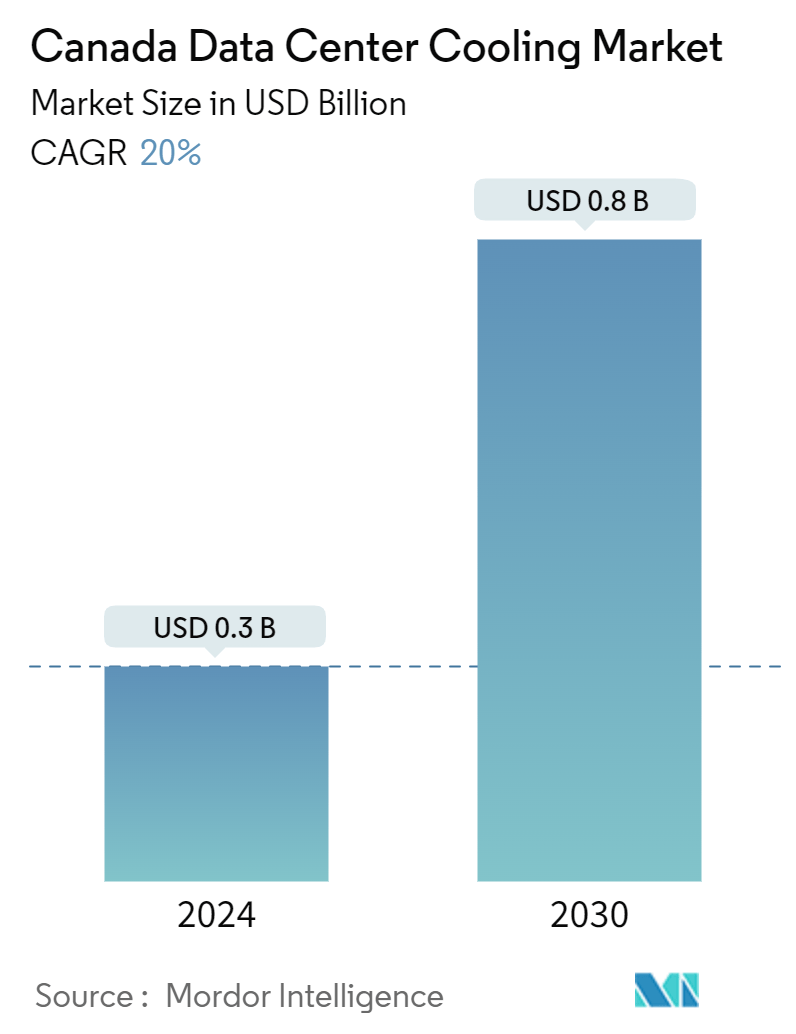Market Size of Canada Data Center Cooling Industry

| Study Period | 2017 - 2030 |
| Base Year For Estimation | 2023 |
| Market Size (2024) | USD 0.3 Billion |
| Market Size (2030) | USD 0.8 Billion |
| CAGR (2024 - 2030) | 20.00 % |
| Market Concentration | Low |
Major Players
*Disclaimer: Major Players sorted in no particular order |
Canada Data Center Cooling Market Analysis
The Canada Data Center Cooling Market size is estimated at USD 0.3 billion in 2024, and is expected to reach USD 0.8 billion by 2030, growing at a CAGR of 20% during the forecast period (2024-2030).
The increasing demand for cloud computing among SMEs, government regulations for local data security, and growing investments by domestic players are some of the major factors driving the demand for data centers in the country.
Under Construction IT Load Capacity: The IT load capacity of the Canadian data center cooling market is expected to reach 1,700 MW by 2030.
Under Construction Raised Floor Space: The country's construction of raised floor area is expected to increase to 6 million sq. ft by 2030.
Planned Racks: The country's total number of racks to be installed is expected to reach 300 thousand units by 2030. Quebec is expected to house the maximum number of racks by 2030.
In Canada's east and west coasts, average high temperatures are recorded in the low 20 °C, while between the coasts, the average summer high temperature varies from 25 °C to 30 °C, with temperatures in some interior locations occasionally exceeding 40 °C. Depending upon climatic conditions, DC cooling is done in the DC facilities.
Planned Submarine Cables: There are close to 16 submarine cable systems connecting Canada, and many are under construction. One such submarine cable, which is estimated to start service in 2025, is Sednalink Fibre. It stretches over 2,104 km with landing points from Goose Bay, Newfoundland, Canada, to Iqaluit, Nunavut, Canada.
Canada Data Center Cooling Industry Segmentation
Data center cooling is a system that helps maintain optimal operating temperatures in data center environments. It is critical, as data center facilities house many computer servers and network equipment that generate heat during operation. Efficient cooling systems are used to dissipate this heat and prevent equipment from overheating, ensuring continued reliable operation of the data center. Methods such as air conditioning, liquid cooling, and hot/cold aisle containment are commonly used to control temperature and humidity in data centers.
The Canadian data center cooling market is segmented by technology (air-based cooling [chiller and economizer, CRAH, cooling towers, and other air-based cooling technologies] and liquid-based cooling [immersion cooling, direct-to-chip cooling, and rear-door heat exchanger]), type of data center (hyperscale, enterprise, and colocation), and end-user industry (it and telecom, retail and consumer goods, healthcare, media and entertainment, federal and institutional agencies, and other end-user industries). The report offers market sizes and forecasts in terms of value (USD) for the above segments.
| By Cooling Technology | ||||||
| ||||||
|
| By Type of Data Center | |
| Hyperscale (Owned and Leased) | |
| Enterprise (On-premise) | |
| Colocation |
| By End-user Industry | |
| IT and Telecom | |
| Retail and Consumer Goods | |
| Healthcare | |
| Media and Entertainment | |
| Federal and Institutional Agencies | |
| Other End-user Industries |
Canada Data Center Cooling Market Size Summary
The Canada Data Center Cooling Market is poised for significant growth, driven by the increasing demand for cloud computing, stringent government regulations on data security, and substantial investments from domestic players. The market is experiencing a shift towards advanced cooling solutions, such as liquid cooling, which offers enhanced energy efficiency and precise temperature control, making it ideal for high-performance computing environments. The integration of technologies like Artificial Intelligence and Machine Learning into cooling systems is further optimizing efficiency and reducing maintenance needs. As Canada continues to develop smart cities and expand its telecommunications infrastructure, the demand for data centers and, consequently, data center cooling solutions is expected to rise.
The market landscape is moderately fragmented, with key players like Rittal GMBH & Co.KG, Schneider Electric SE, and Vertiv Group Corp. leading the charge in expanding their regional presence. Recent strategic partnerships and acquisitions, such as Vertiv's acquisition of Cooltera Ltd and Carrier Global Corporation's collaboration with Strategic Thermal Labs, are enhancing the capabilities of data center cooling solutions. These developments, alongside the anticipated increase in 5G users and the deployment of faster network technologies, are expected to drive the demand for data center cooling infrastructure in Canada over the forecast period.
Canada Data Center Cooling Market Size - Table of Contents
-
1. MARKET INSIGHTS
-
1.1 Market Overview
-
1.2 Key Cost Considerations for Cooling
-
1.2.1 Analysis of the Key Cost Overheads Related to DC Operations with an Eye on DC Cooling
-
1.2.2 Comparative Study of the Cost and Operational Considerations Related to Each Cooling Technology Based on Key Factors such as Design Complexity, PUE, Advantages, Drawbacks, and Extent of Utilization of Natural Weather Conditions
-
1.2.3 Key Innovations and Developments in Data Center Cooling
-
1.2.4 Key Energy Efficiency Practices Adopted in Data Centers
-
-
-
2. MARKET SEGMENTATION
-
2.1 By Cooling Technology
-
2.1.1 Air-based Cooling
-
2.1.1.1 Chiller and Economizer
-
2.1.1.2 CRAH
-
2.1.1.3 Cooling Tower (Covers Direct, Indirect, and Two-stage Cooling)
-
2.1.1.4 Other Air-based Cooling Technologies
-
-
2.1.2 Liquid-based Cooling
-
2.1.2.1 Immersion Cooling
-
2.1.2.2 Direct-to-Chip Cooling
-
2.1.2.3 Rear-Door Heat Exchanger
-
-
-
2.2 By Type of Data Center
-
2.2.1 Hyperscale (Owned and Leased)
-
2.2.2 Enterprise (On-premise)
-
2.2.3 Colocation
-
-
2.3 By End-user Industry
-
2.3.1 IT and Telecom
-
2.3.2 Retail and Consumer Goods
-
2.3.3 Healthcare
-
2.3.4 Media and Entertainment
-
2.3.5 Federal and Institutional Agencies
-
2.3.6 Other End-user Industries
-
-
Canada Data Center Cooling Market Size FAQs
How big is the Canada Data Center Cooling Market?
The Canada Data Center Cooling Market size is expected to reach USD 0.3 billion in 2024 and grow at a CAGR of 20% to reach USD 0.8 billion by 2030.
What is the current Canada Data Center Cooling Market size?
In 2024, the Canada Data Center Cooling Market size is expected to reach USD 0.3 billion.

